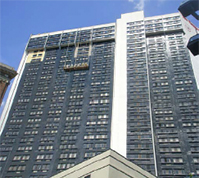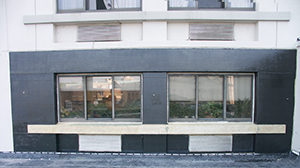Strengthening High-Rise Structures with GFRC and HJ3’s Carbon Fiber Innovations
Back in the 1970s, commercial skyscrapers began integrating Glass Fiber Reinforced Concrete (GFRC) panels into their exteriors, marking a shift toward more modern architectural designs. Unlike conventional pre-cast concrete panels, GFRC panels stood out due to their lightweight and slim profiles, significantly reducing the load on the building's framework. However, these early GFRC facades encountered a critical problem: their long spans made them susceptible to bending under wind pressure, causing extensive cracking and water leakage over time.
HJ3 introduced a groundbreaking carbon strengthening system to address these issues, offering a way to confine cracks and safeguard the panels against further water damage. As the original GFRC exterior endured repeated wind stress, it started showing signs of fatigue and cracking, compromising its durability. This was where HJ3’s advanced technology stepped in to provide a practical and effective solution.
The primary challenge was the inherent flexibility of the long-span panels, which lacked sufficient reinforcement to withstand environmental forces. Additionally, the rigid anchoring system used for these panels prevented any movement, exacerbating the cracking issue. Once cracks formed, they allowed moisture ingress, leading to mold growth and further structural deterioration.
To restore the façade, a meticulous process was followed. The first step involved thoroughly cleaning the surface of the GFRC panels using high-pressure water blasting. Every visible crack was carefully injected with a high-strength epoxy resin, reinforcing the structural integrity of the panels. HJ3’s carbon fabric and resins were pre-cut and pre-batched to ensure seamless application, particularly around corners and expansion joints where precision was key.
After applying the carbon repair system, a UV-resistant gray topcoat was expertly applied to align with the client’s aesthetic preferences. This final touch not only preserved the building’s visual appeal but also enhanced its weather resistance.
HJ3’s carbon fiber system proved instrumental in fortifying the existing GFRC panels, making them more resilient against wind-induced stress, cracking, and fatigue. Beyond that, the system acted as an effective waterproofing layer, blocking any future moisture intrusion. By opting for this restoration method instead of replacing the entire GFRC facade, the client saved approximately $3 million. More importantly, residents were able to stay in the building throughout the entire repair process, avoiding unnecessary disruptions and inconveniences.
â€

â€

â€
This project highlights how innovative solutions like HJ3’s carbon fiber technology can breathe new life into aging infrastructure while maintaining both functionality and aesthetics. It’s a testament to the power of forward-thinking engineering practices in preserving our urban landscapes for future generations.
Wuxi NEST Biotechnology Co.,Ltd , https://www.nest-biotech.com